31 Oct 2023
Laura Watson advises on giving the best guidance to owners regarding the prevention of feline mental well-being conditions.

Figure 6. Multi-cat home cats fed with a wall separating them.
Veterinary professionals have the privilege and responsibility to improve the health of cats by advising caregivers on medical issues and preventive health care. But as well as advising on the patient’s physical health, their mental well-being should be equally considered.
Cats’ environmental needs include their physical surroundings (indoors or outdoors), social interactions and responses to human interactions. Providing caregivers with advice on their cats’ environmental needs and ensuring they are being met can help prevent disease, and reduce anxiety and unwanted behaviours that can be associated with a stressful environment.
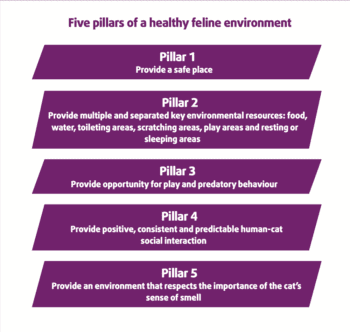
Cats often do not express overt signs of stress and anxiety, and often environmental needs are not addressed until the cat exhibits signs that attract the caregiver’s attention. Often, these overt signals consist of problem behaviours such as:
Potentially causative factors of anxiety and stress are:
Providing care that respects a cat’s needs, both as a species and an individual, stand the best chance of preventing or reducing stress.
Clinics can support caregivers and optimise their cat’s well-being by ensuring the five pillars of a healthy feline environment are being met (Figure 1).
While cats can comfortably live alone or in social groups, they hunt alone and therefore the risk of injury represents a serious survival risk, resulting in the cats avoiding perceived threats. A safe place enables the cat to withdraw from conditions it considers threatening or unfamiliar.
For a cat, a safe place is a private and secure area, often in a raised location. These features give the cat a sense of enclosure, isolation or seclusion. When a cat is relaxed, a safe place can also function as a resting or sleeping area.
Cardboard boxes placed on their side or the cat’s carrier left out in the home provide the cat with easy access to a safe place, with the reassurance of a roof above their heads, which they can perch on. Leaving the cat’s carrier out in the home has multiple advantages:
Draping a blanket over the roof can aid seclusion further, and using top assembling carriers allows the clinic to examine the cat in the base of their carrier if they prefer not to leave the perceived safety the carrier provides.
Perches and shelves provide a high vantage point, allowing the cat to fully stretch out if the ledges are long and wide, and a surface to grip on should be provided. The addition of a hammock-style dip in the middle can help conceal them further. Cat activity towers and radiator beds can also be provided.
Common household furniture can aid hiding and perching, including on or under the human’s bed, on or behind the sofa, or inside or on top of wardrobes and cupboards (Figures 3 and 4).
For cats with outdoor access, safe places should also be provided in the garden. Avoiding vast open spaces by planting shrubs and positioning pots – especially around the cat flap or entry and exit points of the home to help conceal the cat as it moves through its environment, and installing a microchip cat flap to prevent unfamiliar cats entering the home.
Senior cats with OA may struggle to use safe places, so providing shallow steps, ramps or strategically placed furniture at varying heights can help them access much-loved places.
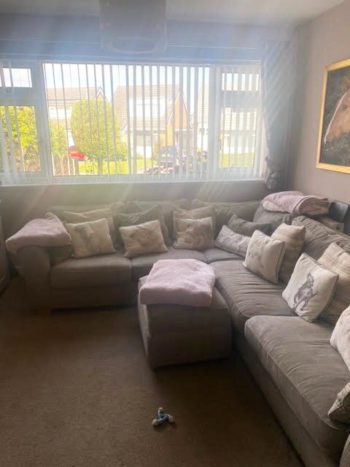
In multi-cat homes, a safe place should have more than one entry to prevent cats blocking access and reducing inter-cat conflict, and sufficient quantity should exist to ensure all cats in the home have individual safe places in separate locations all around the home (Figure 5).
Key environmental resources include feeding, drinking, toileting, scratching, play, and resting and sleeping areas. They should be available in multiple locations, either to provide separate access in multi-cat households or several choices for individual cats.
Each key resource should be placed in its own location, separate from other resources to satisfy their species-specific needs to perform these behaviours in different locations.
Food is vital for a cat’s health, but the way in which we provide food can also affect their welfare. Optimising ways in which to provide eating facilities that consider the cat’s behavioural needs will help enrich their well-being.
Eating is a time of vulnerability for cats; with their heads down, their ability to remain vigilant is reduced, therefore placing bowls away from corners and walls helps them survey their surroundings – especially in multi-cat households. Food should also be placed away from water and litter facilities to prevent contamination.
Cats are solitary predators and so they should never share a food bowl or be fed next to each other because it can lead to perceived competition and obesity from bolting food. They should be fed with a visual barrier between them; a wall, or on different levels, with one cat on the floor and the other on a table (Figure 6).
Raising bowls off the floor can aid senior cats with arthritic neck pain in accessing them more comfortably.
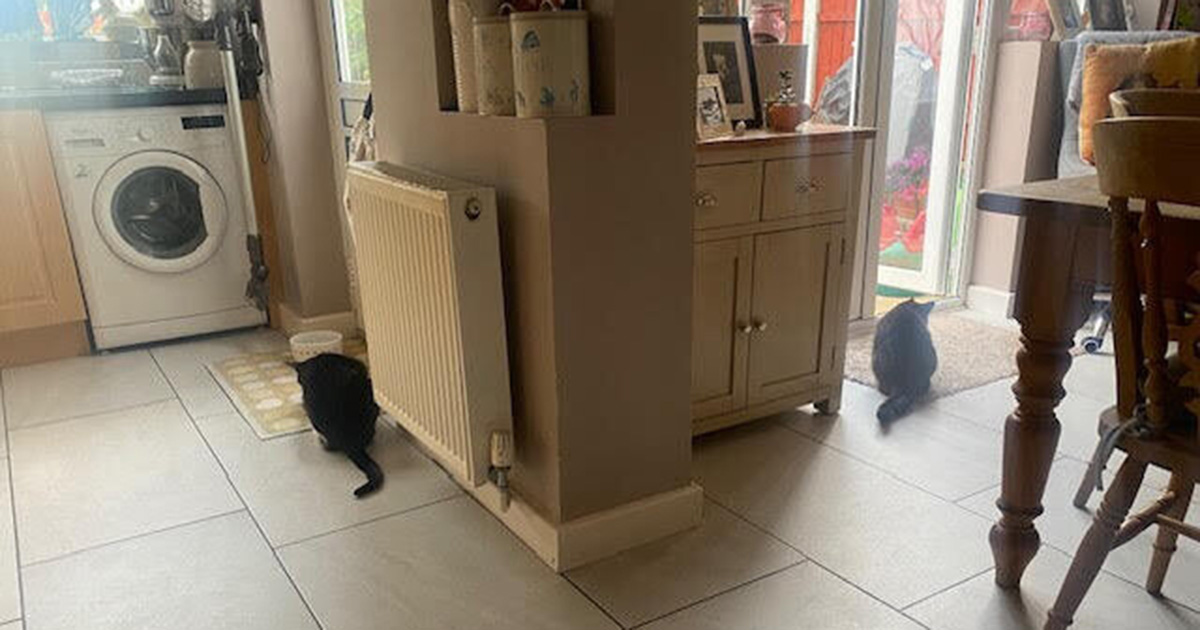
Many owned pet cats are fed a commercial diet, which often contains at least a proportion of dried food, and this can reduce water intake derived from food. Encouraging drinking can increase their water intake and help manage common health conditions – FLUTD, diabetes and chronic kidney disease (select or scan the QR code to download our free encouraging cats to drink poster; Figure 7).
It is common practice for many owners to provide water and food next to one another or in double diner bowls, even though cats prefer to eat and drink in separate locations.
Simply using separate food and water vessels, and moving the water vessel to a separate, quiet location away from noise (washing machines), windows and doors has been shown to significantly increase water consumption.
Plastic containers tend to taint the water with a taste that is unpleasant to cats and should therefore be avoided, and some cats do not like the reflection of metal bowls and collar appendages that can clink against the bowl.
Offering a large, wide glass or ceramic water bowl can help cats see the water surface and avoid the cat shadowing the surface of the water as they drink. It also helps prevent the touching of the cat’s whiskers to the bowl – something they can be very sensitive about.
Water fountains or dripping taps provide the cat with a moving water source if they prefer. Water sources should be cleaned daily and filled to the surface of the bowl.
Cats with outdoor access will tend to toilet outside. Those with no or limited outdoor access should be provided with toileting facilities inside the house in the form of litter trays.
Even if a cat does have unrestricted outdoor access, it is a good idea to provide a litter tray indoors.
Times may occur when a cat feels threatened in the outdoor environment – for example, by a neighbourhood cat, and so not safe enough to toilet outside, or the outdoor environment may not provide ideal toileting facilities.
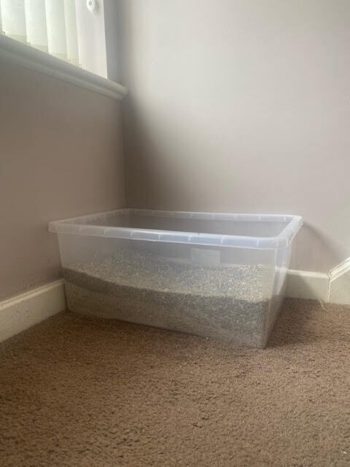
Cat-friendly resources to support toileting include:
Scratching is a normal behaviour for cats to perform to maintain their claws, exercise their muscles, and maintain the system that allows claw extension and withdrawal, used in hunting and climbing and for territorial marking.
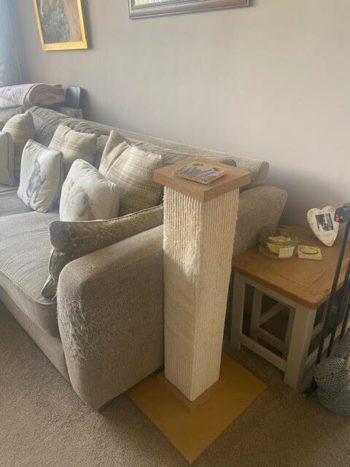
Scratching leaves a visual marker in the form of scratch lines and a chemical marker as pheromones (and perhaps odours) released from the plantar pad glands.
Providing appropriate scratching facilities is not only important for a cat’s welfare and being able to express natural behaviours, but it protects the cat-owner relationship, preventing scratching on undesirable surfaces to the caregiver – for example, furniture and carpets.
Cats can scratch both vertically and horizontally, and therefore should have opportunity to perform both. Scratching facilities should be:
tall or long enough to allow the cat to fully stretch their forelimbs – 60cm minimum length
heavy enough to prevent movement when scratching
made of a suitable substrate to provide resistance – sisal twine, corrugated cardboard, carpet, bark or wood
located near to a sleeping location, entry/exit points, thoroughfares and near places they prefer to scratch, such as a sofa (Figure 9)
Synthetic feline pheromones or catnip sprayed or sprinkled on the scratching surface can encourage their use, as well as playing with a wand toy around or over the post.
Cats should be able to engage in pseudo-predatory play and feeding behaviours. This can be achieved by providing toys, opportunities for play-based interaction with the cat caregiver and with other socially compatible cats, and feeding devices and practices that require the cat to actively acquire food.
We can help cats express as many aspects of the predatory sequence as possible by providing play and feeding activities such as:
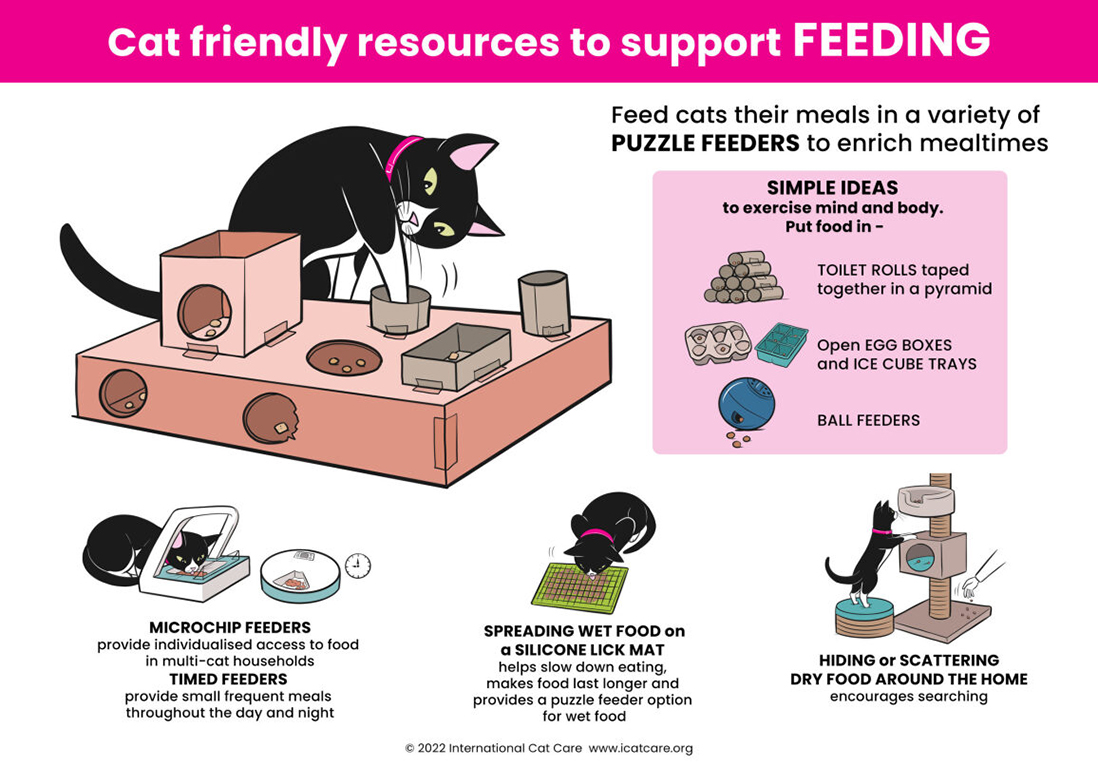
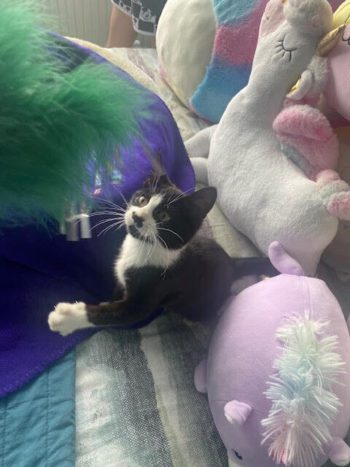
Cats are companion animals that benefit from regular, friendly and predictable social interactions with their caregivers.
Social preferences among cats vary widely and are influenced by factors such as genetics, early rearing conditions in their socialisation period and life experiences.
We can help educate caregivers what behavioural signs their cat is expressing to show they are willing and relaxed to interact with them, such as:
Cats should never be forced to interact with their caregiver – allowing the cat to initiate, choose and control the type of human contact, as well as learning the cat’s individual interaction preferences, will all help build a strong bond.
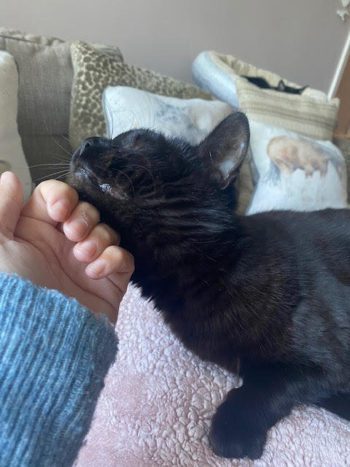
Lower down to the cat’s level, avoid fixed eye contact, and give the cat time to approach and make physical contact, allowing the cat time to choose to sniff their caregiver’s hand (Figure 12). If the cat appears relaxed and wants to interact, gentle stroking on the head and around the cheeks is the most appropriate way to make contact.
Talking gently to the cat can help put it at ease. When a cat ends an interaction by moving away, further interactions should not be forced.
Cats’ individual preferences determine how much they like human interactions, such as petting, grooming, being played with or talked to, being picked up and sitting or laying on a person’s lap. Select or scan the QR code for International Cat Care’s top interaction tips poster (Figure 13).
Cats use olfactory and chemical information to evaluate their surroundings, and maximise their sense of security and comfort.
Olfactory and pheromonal signals deposited when a cat scent marks by facial and body rubbing establishes the boundary of their core living area in which they feel secure and safe.
Veterinary clinics can add an extra value to their services by assessing their patients’ environmental needs and helping owners develop strategies to accommodate them.
Using pre-visit questionnaires emailed to the caregiver prior to their visit or filled in while waiting for their appointment can help the clinic learn more about the cats social and environmental needs (https://bit.ly/3Mk63O1).
Cat Friendly Clinic is a worldwide programme from International Cat Care and its veterinary division, the International Society of Feline Medicine, which supports cats, their caregivers and staff at the veterinary clinic.
To learn more, visit www.icatcare.org and www.catfriendlyclinic.org